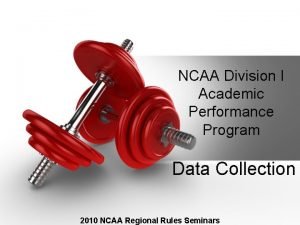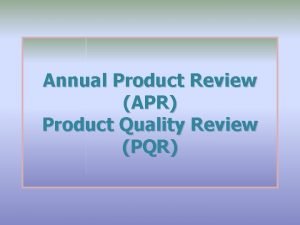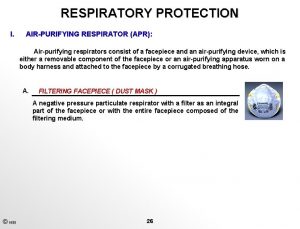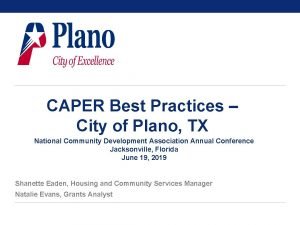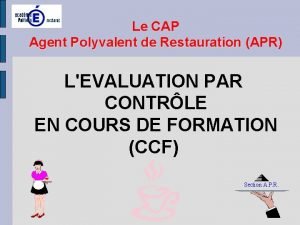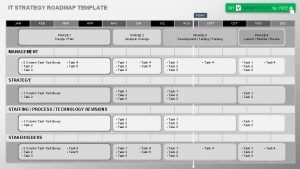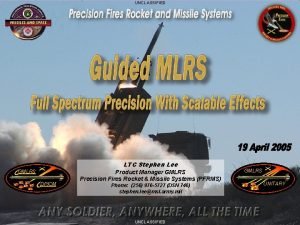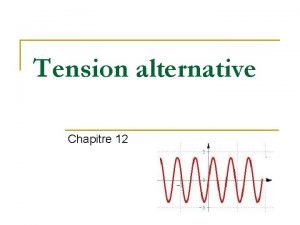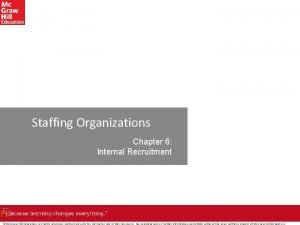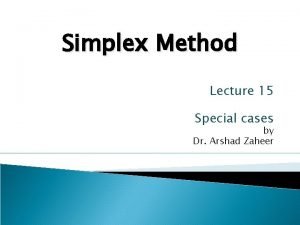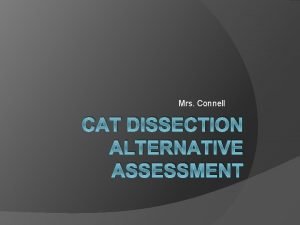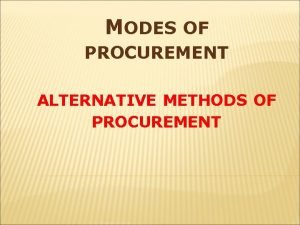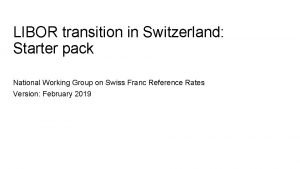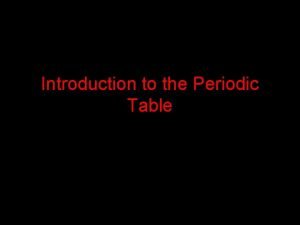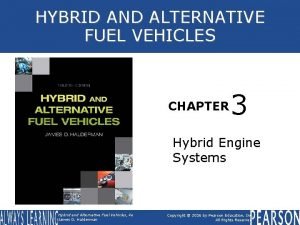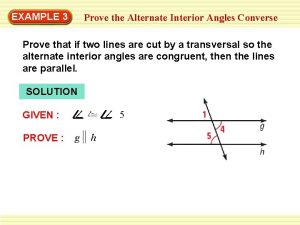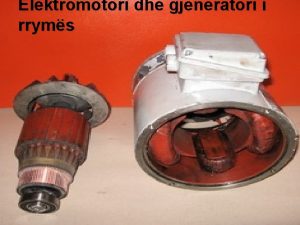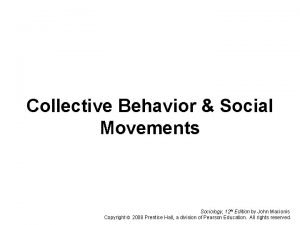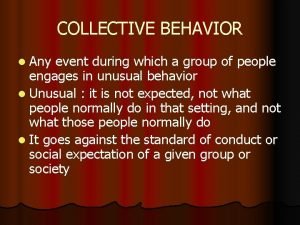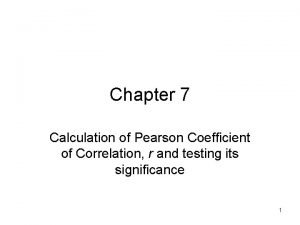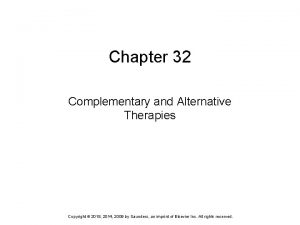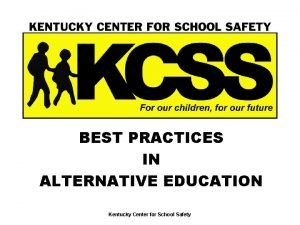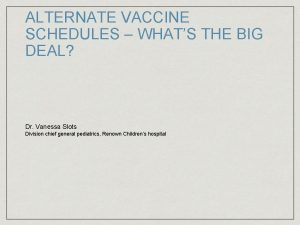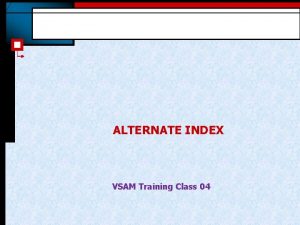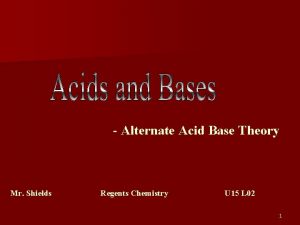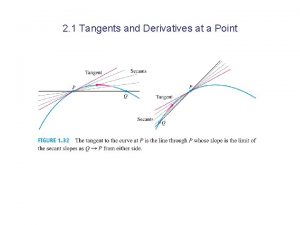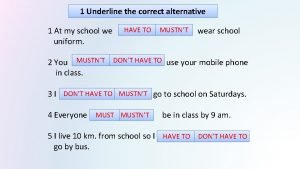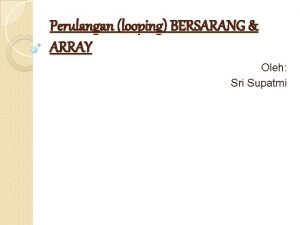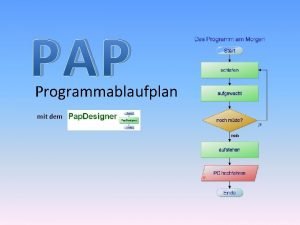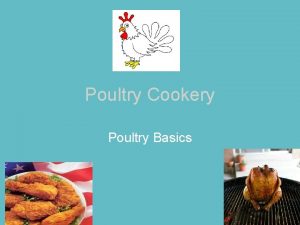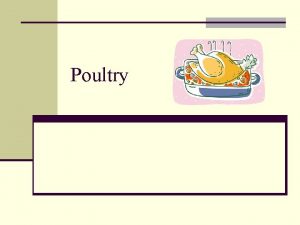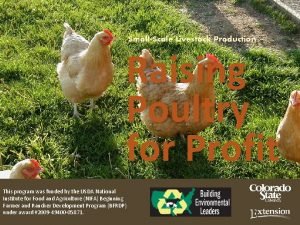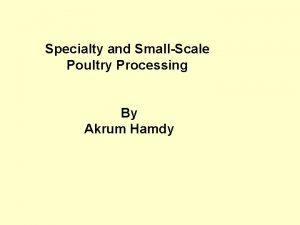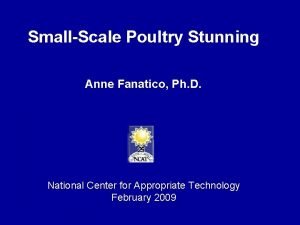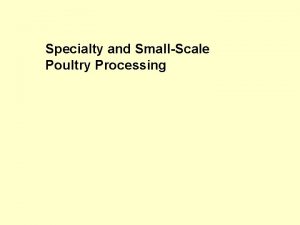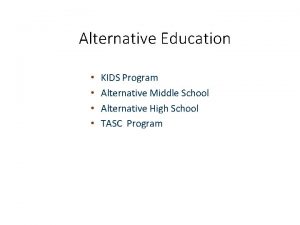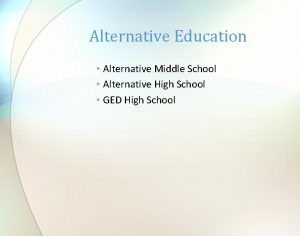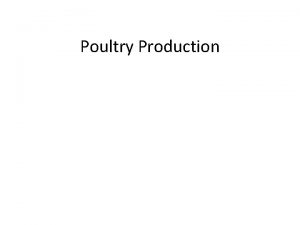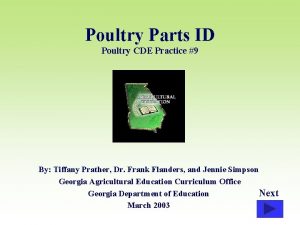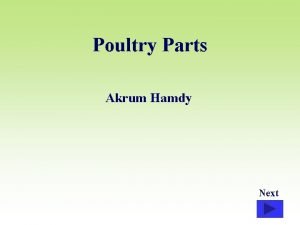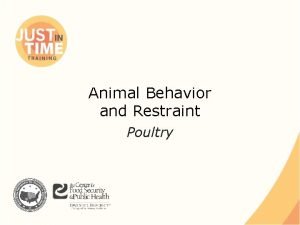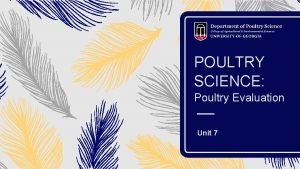Alternative Poultry Production SmallScale Poultry Training Apr 27













































































- Slides: 77

Alternative Poultry Production Small-Scale Poultry Training Apr. 27, 2006 Anne Fanatico Graduate Student/Program Associate Program Specialist

Poultry Production Systems Conventional Layers – cages Broilers – litter

Alternative Poultry Production Systems Enriched cages Cage-free Aviaries

Outdoor access • Allows birds to express natural behaviors (foraging, dustbathing) • Can provide a healthy environment Ample space UV sunlight Fresh air • “Extensive production” vs. “intensive production”

USDA definition for free-range poultry; not very specific “Free-range” permitted on labels after review process • Producer submits description of production • Livestock have free access to out-of-doors for at least 51% of their lives”

Example of Definitions: European Union Free-Range • Finishing feed must at least 70% cereal (low protein) • Minimum age at slaughter: chickens must be 56 days of age or older • Maximum stocking density for indoor area: 13 chickens per 10. 8 ft 2 (with a maximum of 59. 5 lbs of total liveweight) • 13 ft of pophole per 1076 ft 2 of house • Outdoor area mainly covered by vegetation • Birds must have outdoor access for at least half of their lifetime • Maximum stocking density for outdoor area: 1 chicken per 10. 8 ft 2 (4033 chickens/ac)

Traditional Free-Range • Strains: only slow-growing • Minimum age at slaughter: chickens must be at least 81 days • Finishing feed must be at least 70% cereal • Maximum stocking density for indoor area: 12 chickens per 10. 8 ft 2 (with a maximum of 55 lbs of total liveweight) • Maximum stocking density can be increased to 20 chickens if doors are left open at night • 13 ft of pophole per 1076 ft 2 of house • Flock size (house): House can’t have more than 4, 800 chickens • Flock size (site): 17, 222 ft 2 of poultry houses at a single site (limits number of birds) • Chickens must have outdoor access after 6 weeks • Maximum stocking density for outdoor area: 21. 6 ft 2 per chicken (2026 chickens per acre)

Free-Range Production Systems: Fixed House and Yard

Large-scale Automated house Subdivide yards In order to rotate Or rest pasture

Portable housing Moved frequently or infrequently

On wheels Eggmobile

Skids

Floor vs no floor

Use of portable electronet fencing

Houses moved frequently

Houses moved infrequently


Pasture pens Cons: Very labor-intensive to move pens daily by hand, provide little protection from the elements Pros: Flexible, low-cost, good for beginners

Portable shelter Pasture pens are moved daily



Floorless Shelter

Many different types and modifications


Integrated Poultry Production Poultry manure good for building soil fertility for gardens and pastures, organic fertilizer encourages earthworms Cattle parasite control Sheep manage sward for poultry Stagger species in paddock Graze simultaneously Cattle and goats may disturb poultry housing Exclusion feeding Complementary with vegetable production

“Chicken Tractor” Poultry raised with vegetable production for: fertility tillage weed control pest control

“Stack” enterprises: hoophouse overwinters rabbits and layers; grows early vegetables

Poultry and corn in vineyard

Urban Poultry

Eglu for the suburbs

Look back in history

Land Management Provide the same services outdoors as indoors Feed and water outside encourages birds to go outside

Provide shade and shelter Chickens do not like open range

Provide sufficient popholes so birds can find their way outside

Pasture management Poultry obtain limited nutrients from forage Keep forage short and vegetative

• Forage is usually planned for the ruminants • Diverse pasture needed • Cool season: oats; warm-season: clover, alfalfa • Legume forages increase omega-3 fatty acids in eggs and meat

Dryland provides little green forage but has other benefits of outdoor access

• Rotate pastures every 2 -3 months • Mobile house is ideal • If house is fixed, subdivide yard into at least 4 yards

Multiple yarding Source: Thear, 1997

Consequences of not rotating/resting: • Turf damage • Pathogens build up • Excessive nutrients

Predator Control Ground predator control: • Electronet fencing • Humane traps Overhead predator control: • Net covering • Interfere with flight Long rectangle yards String Guardian dogs

Housing protects chickens from rain, wind, sun, predators, Insulation reduces temperature extremes Many styles depending on Shelter vs. house Fixed vs. portable

Materials: • Built of wood, sheet metal, poultry wire • Concrete, brick • Developing countries: Adobe, bamboo, thatch Roof: • Rainproof: Tarps, sheet metal, shingles, wood • Roof should have a large overhang to provide shade and prevent rain from getting in • Insulated Power

Orient so birds are not exposed to direct sunlight Floor: dirt, gravel with wire mesh to keep out rats, concrete Raised floor: wood, slats Solid floor: use litter Make house easy to clean



Ventilation Usually natural because popholes open Makes use of air movement (hot air rises, cold air falls) Build roof high above floor to create differential Open side walls or curtains for cross ventilation Mechanical ventilation (fans) can help exhaust air out building more quickly Ventilation tricky in winter because producers keep house more tightly closed

Temperature If house is not heated, birds eat more in cold weather to stay warm Heat stress is more of a problem Should not be over 85 F in house, birds pant Use a thermometer to display recent high and low

Lighting Dark period is needed for good health Usually natural in alternative poultry production Usually bright Reduce intensity if aggression occurs Incandescent or fluorescent Artificial light important for managing layers Electrical, battery-powered, kerosene

Litter dilutes manure Wood shavings, rice hulls Keep litter in good condition; wet litter causes many problems 30% moisture Clean out Litter provides nutrients for crops and forage Compost is good soil amendment

Alternative litter management Interest in composting litter to reduce volume and to provide a healthy, probiotic environment Requires more carbon

Air Quality Measure ammonia levels Paper strips Drag tubes Meter

Small-Scale Brooding Heat lamps Hovers

Standing, insulated Hover; electrical

Outdoor access during brooding

Warm litter before chicks arrive Put feed in pans Keep chicks at 90 F and with full light for first few days

Rodent Control • Habitat reduction • Physical exclusion from facilities and feed • Trapping • Predators • Rodenticides/Baits • Anticoagulents • Vitamin D metabolites • Single dose toxins • Sulfur dioxide (smoke bombs) for underground control

Equipment: Waterers Simplest type of water Can inverted on a pan To keep litter dry, place waterer on wire-covered platform

Buckets can provide small reservoirs, but carrying buckets of water is labor-intensive; Serving mobile houses or pens is difficult

To reduce having to refill waterers often, use a large barrel connected to the waterer; gravity fed


Pipe in water Reduces labor



Types of waterers: Founts (not automatic) Float value Bowl Bell Nipple


Cleanliness • Water sources • Water quality • Don’t let birds drink out of puddles Too cold • Use bucket heaters or heating tape to prevent freezes • Use all metal values for freezable systems; plastic splits Too hot • Shade water • Use a large reservoir

Feeders Troughs Put a spin bar on top to prevent roosting Enough feeder space should be provided so all birds can feed at one time

Troughs: Only put in a small amount of feed at a time to prevent wasting (feed several times a day)

Old style trough Height of ledge can be adjusted


Bin Feeders Store feed so no need to feed several times per day

Hanging feeder Adjust feeders to bird back level Feeder and waterer should be raised here

Range feeders

Bulk feeders

Automated systems Pan feeders

Perches Chickens like to roost at night Nestboxes Baskets, cardboard boxes, pots Dust-bath
 Alir proses produksi multimedia
Alir proses produksi multimedia Do chickens have vaginas
Do chickens have vaginas Apr vs ear
Apr vs ear Nominal vs real return
Nominal vs real return What does apr stand for
What does apr stand for Apr vs ear
Apr vs ear Ncaa apr database
Ncaa apr database Apr/pqr
Apr/pqr Air purifying respirator (apr)
Air purifying respirator (apr) àpr
àpr Sistem za centralizovano prijavljivanje korisnika apr
Sistem za centralizovano prijavljivanje korisnika apr Cours cap apr
Cours cap apr Data strategy roadmap template
Data strategy roadmap template Training is expensive without training it is more expensive
Training is expensive without training it is more expensive Metode of the job training
Metode of the job training Aggression replacement training facilitator training
Aggression replacement training facilitator training Sjacl
Sjacl Veyon
Veyon Gmlrs
Gmlrs Générateur de tension alternative
Générateur de tension alternative Storyworth alternative
Storyworth alternative Planning alternative tomorrows with hope
Planning alternative tomorrows with hope Cover uncover test vs alternating cover test
Cover uncover test vs alternating cover test Internal recruitment definition
Internal recruitment definition Reformative social movement
Reformative social movement Simulink alternative
Simulink alternative Alternative optima
Alternative optima Wiebke oschmann
Wiebke oschmann Renewable source of energy definition
Renewable source of energy definition Regio graph
Regio graph Promoting alternative thinking strategies
Promoting alternative thinking strategies Oklahoma department of career and technology education
Oklahoma department of career and technology education West virginia alternative teacher certification
West virginia alternative teacher certification Dissection alternative assignment
Dissection alternative assignment Method of procurement
Method of procurement Lone star college alternative teaching certification
Lone star college alternative teaching certification Swiss starter pack
Swiss starter pack Periodic table by stowe and tarantola
Periodic table by stowe and tarantola Alternative marketing
Alternative marketing Fuel pressure regulator diagram
Fuel pressure regulator diagram Lincoln street alternative high school
Lincoln street alternative high school Alternate interior angles
Alternate interior angles Elektromotori dhe gjeneratori
Elektromotori dhe gjeneratori Ecap wetumpka
Ecap wetumpka Alternative hypothesis
Alternative hypothesis Alternative flow use case
Alternative flow use case Planning alternative tomorrows with hope
Planning alternative tomorrows with hope Single alternative decision structure
Single alternative decision structure What is adequate service
What is adequate service What is a social movement sociology
What is a social movement sociology Redemptive social movement
Redemptive social movement Alternative programming languages
Alternative programming languages Ssxx equation
Ssxx equation Chapter 32 complementary and alternative therapies
Chapter 32 complementary and alternative therapies Alternative social movement
Alternative social movement Tube2gram alternative
Tube2gram alternative Alternative forms of business organization
Alternative forms of business organization Bgan alternative
Bgan alternative Alternative school definition
Alternative school definition Cornea
Cornea Axigen alternative
Axigen alternative Acebf
Acebf Dhh operator certification
Dhh operator certification Alternative operating systems
Alternative operating systems Delayed vaccine schedule
Delayed vaccine schedule Build index in vsam
Build index in vsam Alternate acid theory definition
Alternate acid theory definition Derivative
Derivative Null and alternative hypothesis examples
Null and alternative hypothesis examples Underline the correct alternative:
Underline the correct alternative: Piratepad alternative
Piratepad alternative Storyworth alternative
Storyworth alternative Elektromotori
Elektromotori Is nested loops bad
Is nested loops bad Flussdiagramm unterprogramm
Flussdiagramm unterprogramm Alternative passion
Alternative passion Pv&e
Pv&e Maxcut alternative
Maxcut alternative






